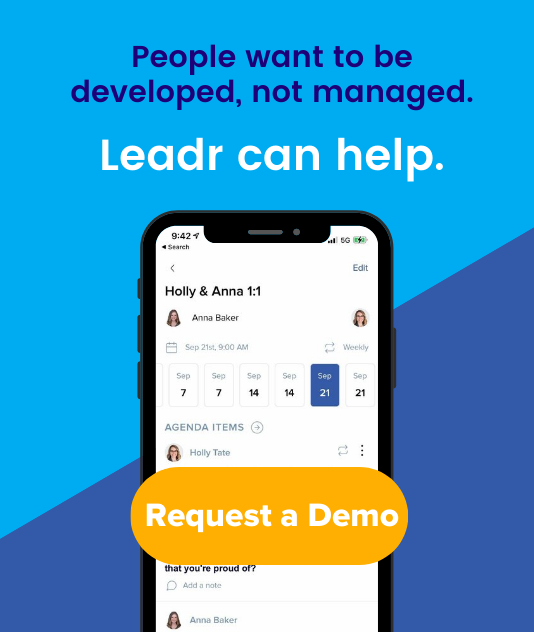Strengthening Your Leadership Development Program
As a leader, your job is twofold: cast a vision for the future and develop your team on the way to reaching that goal. You equip them with a plan for how to reach the vision as you lead them in their day-to-day work, and these two goals go hand in hand - in fact, you likely can’t have one without the other. Your team needs consistent, ongoing leadership from you as much as they need the initial creative, big-picture idea to work towards.
If you don’t have consistent development in your team, your vision will become blurry as team members struggle to unify their work with the big picture. Many employees say a lack of engagement and overall happiness with both the company and their direct supervisor are key reasons they look for a different job.
Companies in this situation may find that it’s helpful to sit down and rethink and redevelop their leadership strategies. Begin with hiring - are you hiring the right leaders for your team? Is onboarding effective in communicating vision and culture? For supervisors already in a leadership role at the company, do they have consistent and clear goals for coaching their team rather than managing them? And, is the leadership track open to others in the company who’d make a good fit for future roles?
These questions will open doors to a transformative and ongoing conversation about how great and effective leadership is a vital guide to a strong vision and thriving culture, supported by a team that wants to stay for the long term.
Rethink the Hiring Process
Why are great managers so rare? If you think back over your career, you can probably think of both a bad manager and an excellent one. What traits set apart the great ones from the not-so-great ones, and what elevates a manager from a good one to a stellar one?
Developing and retaining key talent is crucial to the success of your organization. But often the process falls short: leaders aren’t developing other leaders. Research from Korn Ferry shows that when managers rated themselves on 67 different leadership skills, “developing others” came in last. A lack of confidence or even bad hiring practices can contribute greatly to ineffective leadership. As you conduct interviews for new team members in a leadership position, consider that just because someone had success in their last job doesn’t necessarily mean they already know how to manage others. Good leadership is like a muscle - the more you develop it, the stronger it gets. It takes continuous work and commitment to learning to grow into an effective leader.
When an employee is internally promoted to a leadership position, there is another opportunity to reflect and rethink the process. Why was this person chosen to lead a team, and what unique characteristics or skills do they already have that will serve them well in this role? What skills do they need that they might not have? These are crucial questions that clarify the framework for the development of a leader, again, which is the continuous work they need to lead their team well. It’s not enough that they were successful in their last role - there’s so much more under the surface. Good communication and people skills are an excellent foundation for any employee, but especially for a leader in an age where hybrid or remote work is becoming more normal.
Invest in your team - doing this now sets you up for tenfold success months from now. And thoughtfully consider each member of your team - it’s ok if someone isn’t the right fit for a leadership promotion, or isn’t ready yet but could be. The value of a team is that each person brings unique skills, gifts, and backgrounds to their role. You may have team members who thrive in their role because of the development they’ve received from their boss, but you may also have people who are ready to take the leap with the right mentorship and development.
Whether a manager or direct report, development is key to team members feeling satisfied and fulfilled in their roles, and ultimately wanting to stay.

Coaching instead of Managing
The word “coach” may make you think of Friday night football or Olympian success. Coaches are the backbone of sports. They’re always on the sidelines, watching their athlete perform or compete, offering guidance and insight, and at times, course correction.
In their roles, they are like a manager in a corporate setting. But they also do some things differently that make them a great case study for developing leaders. This includes a daily focus on studying and improving talent that leads to calculated decision-making. They are heavily involved in the day-to-day life of these athletes. They need to be this involved because of how quickly things change in their game or with their athlete. An injury or a new opponent means they have to be agile and adjust their plan. They take time to debrief after a game or a competition to ask, what were the wins and what could we do better? An engaged coach has a tremendous amount of influence with their team.
How often do you take a “coach approach” as a manager? Probably not as often as you could to maximize the effectiveness of this method of leadership. It may sound simple, but there’s a big difference between being a boss and being a coach. Focusing on engagement in a proactive way rather than managing with a reactive style allows you to adapt to changing situations, strategically position talent to maximize success and nurture strengths for better employee satisfaction.
It’s important to note that regular one on ones is a key part of this method of leadership. Productive, two-way 1:1s allow you insight into your direct report’s role and allows you to equip them through development to develop processes that work, to triage and handle issues on their own, or proactively avoid issues in the first place. Make the 1:1 a setting where listening happens equally on both sides, and make sure your team knows you care about them as a person - as a manager, your work is sometimes more about people and relationships than it is about the actual work you’re doing. You’ll find that relationship-focused coaching naturally increases productivity and retention, which allows you to keep growing as a company and matching competition effortlessly.
Investing in employee development is about protecting the company’s most valuable asset – its people.
Personalized Development is Key to Elevating Your Team’s Success
As a manager, you already know that a happy employee wants to stay in their job. Employee happiness and satisfaction can encompass more than just a competitive salary or nice perks of the job, though.
A big part of employee satisfaction is how connected they feel to their manager. If your team knows your leadership style, feels comfortable approaching you with problems and wins, and senses that you have taken the time to get to know them as individuals, that goes a long way in employee retention too.
Teams are much more likely to succeed in meeting company and team goals when employee engagement is a focus, leading to a significant decrease in factors like turnover and absenteeism, and an increase in productivity.
Overall, development programs foster new skills, encourages teamwork and collaboration, and could even help your meetings be more efficient and productive.
But it’s also important to note that this relationship-building happens through personalized development as well as whole team development because not every team member will work or think the same way.
Start by taking the time to build genuine relationships and work collaboratively with team members one on one in various ways they can grow. An effective leader mentoring an up-and-coming leader has an end goal for their mentee in mind. They understand that there’s a trajectory of growth needed to go from employee to manager. Different people will respond differently to situations, but this is a strength! Creative problem solving and the ability to see things from a different perspective are characteristics you can develop in others as you see how they work on their own and with others.
The problem with some corporate development programs is that they are one size fits all, which doesn’t maximize the potential of people with very different strengths and backgrounds or interests in different areas of leadership.
Having a one-size-fits-all for development has become the norm for growth in many companies. This approach to employee development has good intentions: it often provides structure and routine for the learner and saves the company time and resources. But it can also diminish the employee’s potential by not focusing on their strengths.
How do companies develop the high potential employees on teams, equip existing managers to build their team, and retain key talent that is crucial to its success?
At Leadr, we think the ticket to sustainable growth is focusing on personalized development plans.
Customizing development is a critical part of your growth as a company. It can help you evaluate the stage a leader is in, and create a specific, measurable, actionable and timely path for learning and growth.
Personalized development can bridge the gap between being a great employee and a great leader. Download our free guide to building your comprehensive leadership development program to get started today.
.png)
Share this
You May Also Like
These Related Stories
How-to: Personalized Development Plans

The Secret To Hiring And Retaining Gen Z




No Comments Yet
Let us know what you think